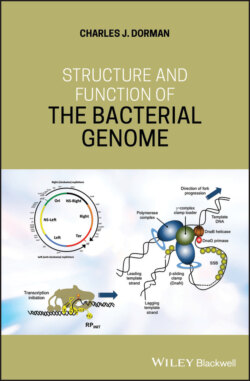Читать книгу Structure and Function of the Bacterial Genome - Charles J. Dorman - Страница 33
1.22 MatP, the matS Site and Ter Organisation
ОглавлениеThe 17‐kDa MatP protein binds to 23 high‐affinity matS sites found exclusively within the Ter macrodomain of the E. coli chromosome (Mercier et al. 2008; Thiel et al. 2012). The Ter domains of both chromosome I and chromosome II of V. cholerae also have matS sites that are bound by MatP and these affect the spatiotemporal coordination of the replication and segregation of both chromosomes (Demarre et al. 2014). Counterparts of matS are present in the Ter regions of the chromosomes of Erwinia carotovora, S. enterica serovar Typhimurium LT2, and Yersinia pestis (Mercier et al. 2008). MatP forms bridged tetramers that link distant matS sites to condense the Ter DNA (Dupaigne et al. 2012). MatP interacts with ZapB, a cell division‐associated protein, to position the Ter macrodomain at the cell midpoint and to ensure its segregation (Espéli et al. 2012). With proteins ZapA, C, and D, ZapB functions to organise the Z ring that acts as a scaffold for the assembly of the complexes responsible for cell division (Buss et al. 2013). ZapB is dependent on ZapA for interaction with the tubulin‐like FtsZ protein (Galli and Gerdes 2010). MatP also interacts with the MukBEF‐Topo‐IV complex at the Ter macrodomain, displacing MukBEF from Ter and facilitating its interaction with the Ori macrodomain. This is part of a step‐wise process in which MukBEF manoeuvres the chromosome such that Ori and Ter adopt their assigned positions at the pole and mid‐cell, respectively, by the time cell division takes place (Lioy et al. 2018; Nolivos et al. 2016). Together with MukBEF and SeqA, MatP is part of a group of proteins found exclusively in bacteria that express the Dam methyltransferase (Brezellec et al. 2006; Mercier et al. 2008).
